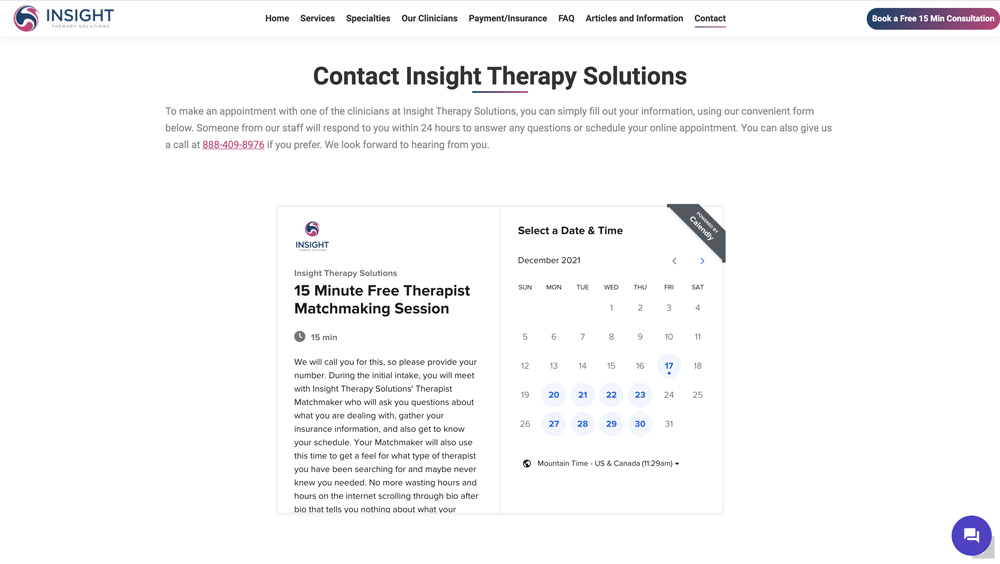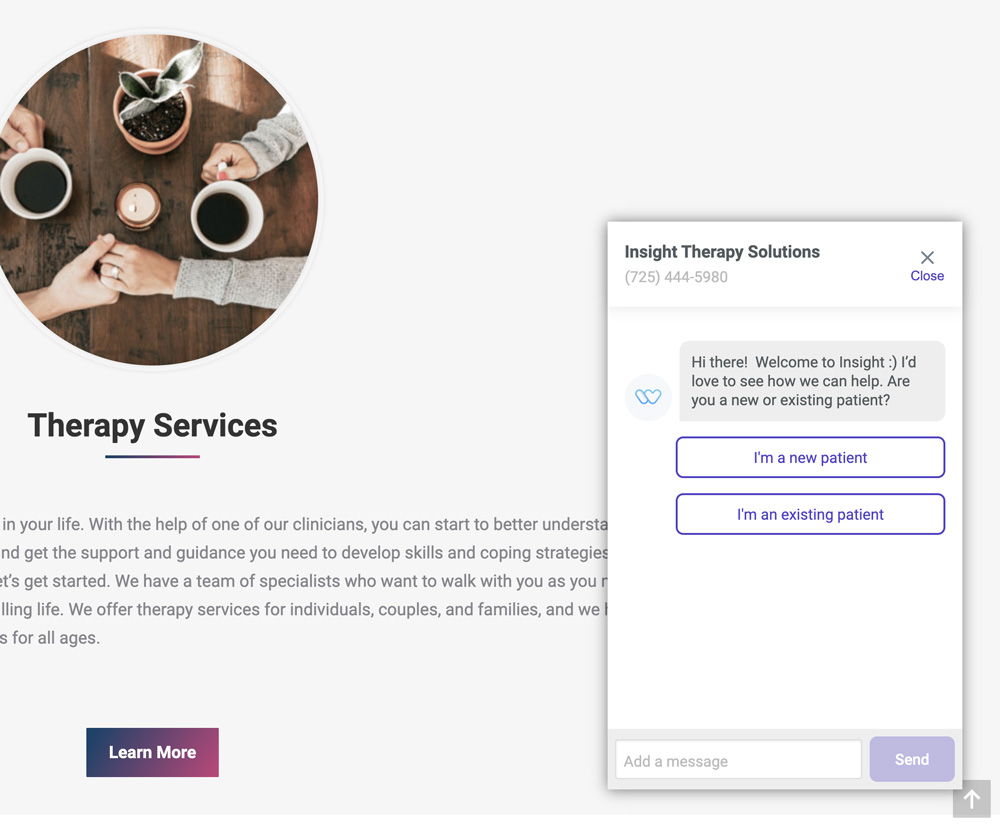With a new year, most private practice owners have new aspirations for their businesses. Goals to better help their clients, out rank their competitors and grow. To help you in your New Year’s resolutions, here are some tips to help prepare your therapy or mental wellness website for 2022’s Search Engine Optimization requirements and improve your overall online presence.
1. Telehealth or bust.
If you don’t already have a telehealth platform for your therapy practice, first off, where were you doing the last two years?
Exploding into the forefront of healthcare due to a worldwide pandemic and national-wide shutdowns, online therapy is here to stay. Benefits include accessibility, flexibility and added confidentiality for clients, while clinicians benefit from a wider geographic outreach, less cancellations and no shows, and the same flexibility and convenience their clients have access to.
While there are some cons to telehealth, and some people may be more comfortable with in-person therapy, it’s best to offer both options to your clients. If you haven’t already, see how you can incorporate HIPAA compliant telehealth options into your practice and be sure to highlight that you provide these options on your website.
2. Niche your services.
While it’s great to want to help everyone at your private practice, you may have found yourself scrambling to find clients. Even though you’ve listed everything you could possibly provide on your website, your inbox is at a trickle and the phone calls just aren’t coming in. Fact is, having too broad of an ideal customer or audience may actually hinder your business.
Time to niche it down. While it may seem counter intuitive, really pinpointing your ideal client can lead to better marketing for your website (think rankings) and better leads for your private practice. Who do you enjoy working with most? What kind of mental health disorders or challenges do you excel at treating? Find what you specialize in.
Whatever your niche is, be sure to use your niche’s (or specialty’s) keywords throughout your website’s content. For example, if you want to specialize in anxiety therapy for young people, consider keywords like “stress therapy” “burnout therapy” “anxiety therapy for teens” etc. Along with keywords related to your niche, don’t forget your location keywords.
3. Make your website work for you.
If you haven’t linked your practice management software (PMS) to your website in some way, it’s time to do just that. This is especially important if you use your PMS to schedule clients’ initial intake interviews or sessions. If you don’t use your PMS to schedule therapy appointments, consider adding a scheduling widget to your website from software like Calendly or Acuity.
By adding scheduling directly to your website, you can save a couple steps when it comes to making appointments. If you have a PMS with scheduling abilities, you can allow current patients to schedule future appointments or funnel new patients towards the steps they need in order to schedule an initial session. Even with basic scheduling software, you can have potential clients schedule a consultation appointment so that you quickly sort out the appropriate information before proceeding with the client.
Last, but not least, you can link your PMS or EMR to your website, allowing current clients to easily find the client portal and check their records, appointments or send you confidential messages.

4. Consider a chatbot.
Chatbots may not be ideal for every therapist, but for some, using a chatbot on their website may be beneficial. In a nutshell, a chatbot can serve as a messaging app for your website (think an automated receptionist,) guiding potential clients to the correct pages, contact information and even answer their questions. In some cases, a chatbot can also be used as a live chat by you or your intake coordinator, allowing clients to directly speak with you or your office during scheduled times.


4. Consider a chatbot.
Chatbots may not be ideal for every therapist, but for some, using a chatbot on their website may be beneficial. In a nutshell, a chatbot can serve as a messaging app for your website (think an automated receptionist,) guiding potential clients to the correct pages, contact information and even answer their questions. In some cases, a chatbot can also be used as a live chat by you or your intake coordinator, allowing clients to directly speak with you or your office during scheduled times.
5. Make sure your website is up to speed.
While a whole blog post (or multiple articles) could be dedicated to how Google ranks websites, it’s best to keep it simple and say that yes, your website’s user experience, and thus, load time (aka speed) matters. While it is not the only ranking factor in Google’s ranking algorithm, it is a fairly important one.
It’s imperative in 2022 to monitor your website’s Core Web Vitals aka your site’s performance, according to Google. If you’re in the “green” you’re golden, but if you’re struggling in the red or orange, it’s best to take a look at what’s slowing your website down.
6. Is your website ADA compliant?
The Americans with Disabilities Act serves to ensure those with differing abilities have equal access to opportunities, goods, services and programs. What does this mean for websites, particularly yours? While the exact requirements are still murky, and no, you do not have to be ADA compliant, it’s still important to ensure that people with varying disabilities have access to your website.
Some steps to having an ADA compliant on website include:
- Alt tags for images
- Proper usage of header tags and content tags
- Appropriate labels for buttons
- Accessible fonts
- Text-transcripts for all audio and videos
If you’d like to see the full guidelines, click here.
7. Include videos in your online content and website.
We’ve all seen the rise of TikTok, but that doesn’t mean you have to start learning the latest dance moves to step up your SEO game (although by all means, go for it!) Any video content is good. If you like the TikTok medium, try something like “60 Second Therapy” and give snippets of mental wellness advice. Creating introduction videos for therapists in your practice is also an excellent way for clients to get a better idea of who they may be working with and can help encourage them to follow through with contacting you.
As with any content, make sure your video descriptions include relevant keywords!


7. Include videos in your online content and website.
We’ve all seen the rise of TikTok, but that doesn’t mean you have to start learning the latest dance moves to step up your SEO game (although by all means, go for it!) Any video content is good. If you like the TikTok medium, try something like “60 Second Therapy” and give snippets of mental wellness advice. Creating introduction videos for therapists in your practice is also an excellent way for clients to get a better idea of who they may be working with and can help encourage them to follow through with contacting you.
As with any content, make sure your video descriptions include relevant keywords!
8. Content is still queen. (Or king.)
If it hasn’t been hammered into your head enough, hammer it in now. Content is still your #1 tool when it comes to making sure your private practice website ranks and serves your audience well. Your website is just a pretty screen to look at if your content is sparse, poorly written and devoid of appropriate keywords and location indicators.
How can you ensure your content is quality? Follow Google’s EAT principles:
- Expertise
- Authoritativeness
- Trustworthiness
What exactly doesn’t this mean? Essentially, keep your content up to date, check your facts, get people to review you and/or link back to your site, write like the professional you are and make sure all content you post is well thought out and not just fluff.
9. Ramp up support for People of Color (BIPOC.)
We can all do our part to be more inclusive. Some of the ways therapists, psychologists and other mental health counselors can do this include:
- Hire BIPOC or those who have experience working with BIPOC
- Provide inclusive resources or share them on your social media
- Start support groups that speak to BIPOC issues
- Consider providing sliding-scale services
Last, but not least, continue doing what you do best as a mental health professional; listen with intention and provide authentic support.
If you’re looking for a few ways to boost your website this year, start with these tips. You might be surprised to see how your business grows. If you’d like help with any or all of these above, I might know the right gal for you. 😉 Feel free to reach out!
And finally, best wishes for a happy and successful 2022!

About the Author
Abby Jacobs runs this shindig called good.design, offering web design, branding and other creative solutions for businesses, in particular therapists, psychologists and other mental health professionals. When she’s not glued to a computer, she’s being walked by her dogs, hiking, baking or gardening.




